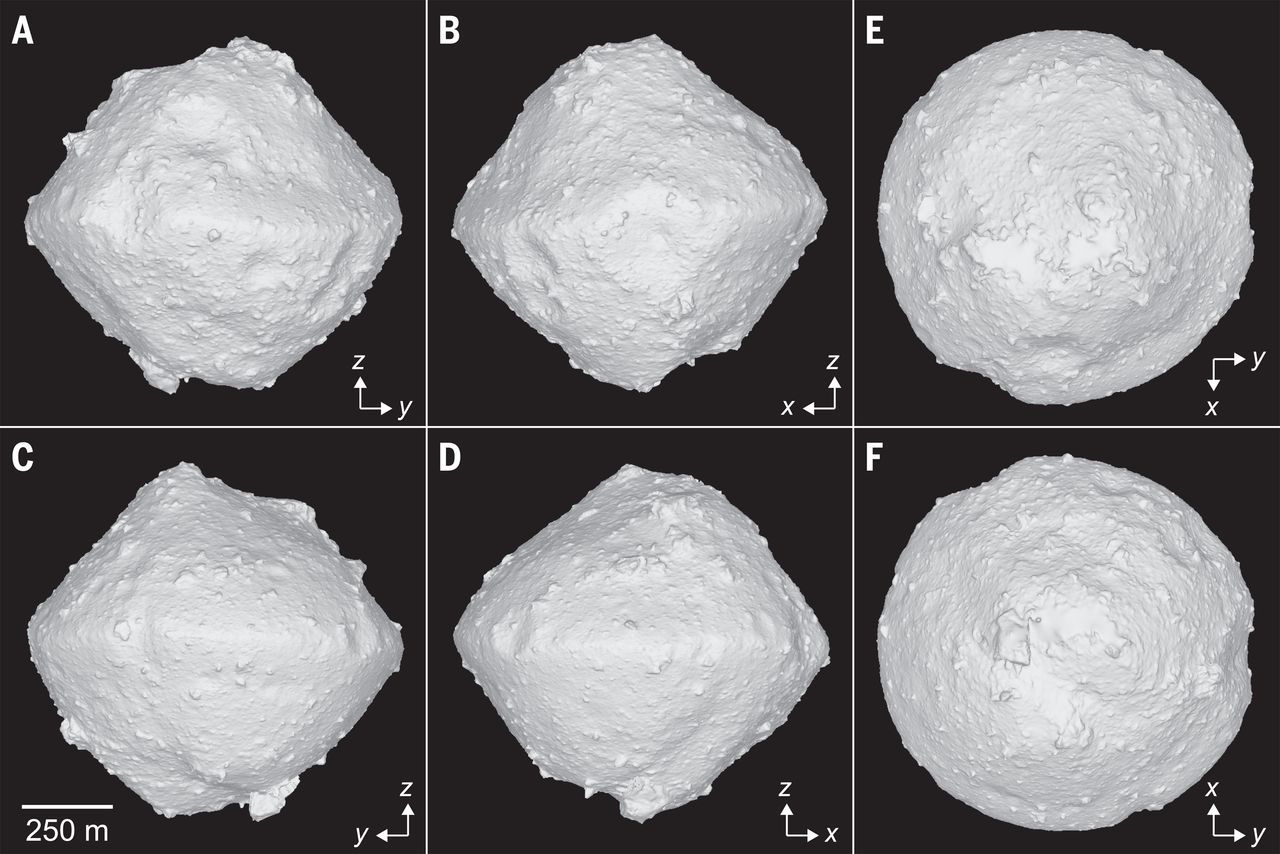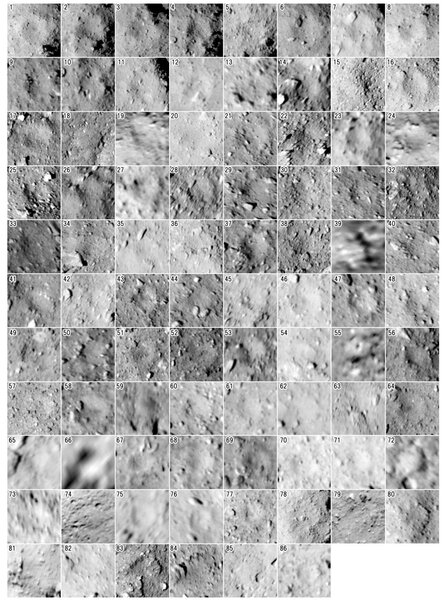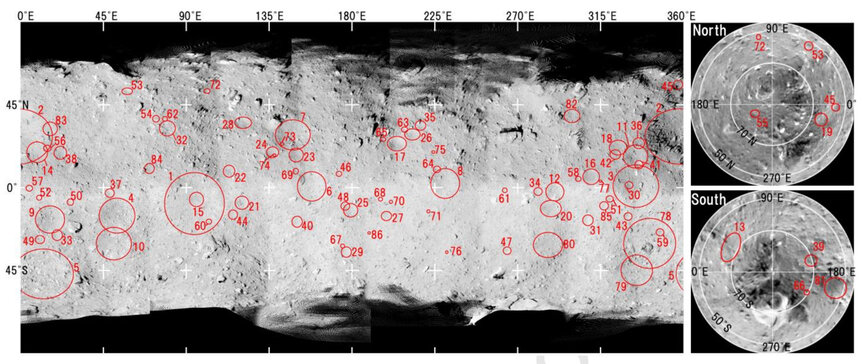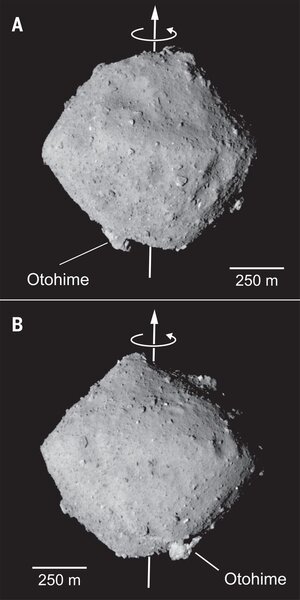Create a free profile to get unlimited access to exclusive videos, sweepstakes, and more!
Ryugu’s history has been… weird

The Japanese Space Agency mission Hayabusa2 left its asteroid target, Ryugu, just a few weeks ago, after surveying the 1-kilometer-wide rock for the past year and a half. The spacecraft is heading back to Earth now, carrying several samples of the asteroid that will drop to Earth so scientists can study them in the lab.
But the science has already begun with this mission. A team of scientists looked at the craters on Ryugu, and were able to use them to deduce some of the history of the asteroid. And hey, we already knew Ryugu was weird — it’s shaped like two cones attached by their bases, and is basically a pile of rocks held together by their mutual (and very meager) gravity — but it turns out it’s even weirder than first thought.
Using imaging data from Hayabusa2, the scientists found a total of 77 distinct craters and a handful that weren’t clear. They believe their list is complete for craters bigger than 20 meters, and were able to ID a few smaller than that. There are 3 bigger than 200 meters wide, and 11 more than 100 meters wide. There are two ways to look at the data: One is to examine the size distribution of the craters, and the other is to look at the spatial distribution of them (that is, where they are on the surface).
The size distribution is curious, as there’s a lack of craters smaller than 100 meters compared to what you’d expect given the number of large craters; this has been seen on other asteroids like Itokawa, Eros, and Bennu (ones that have had their surfaces mapped by spacecraft). It’s possible that the energy from smaller impactors gets absorbed by boulders on the surface (which fracture), or that seismic disturbances from other impacts shake the asteroid and fill in smaller craters. Clearly this is something that happens with smaller asteroids (Bennu and Itokawa are in the kilometer range, and Eros is a potato about 34 km long). This implies the top 1 meter of Ryugu is resurfaced every million years or so, likely from small impacts shaking the asteroid.
But it’s the spatial distribution of craters that’s really odd. If impacts were random, and craters lasted forever, you’d expect a random distribution of craters over the surface. This can be tested statistically, repeatedly modeling where craters would be if they hit randomly and then aggregating all the results. They found pretty big deviations from this when looking at the real cratering, strongly suggesting that the craters are not randomly distributed across the surface. This doesn’t mean someone shot a cannon over and over again at the same places! Instead, it means that the surface of the wee asteroid has been modified a lot over time.
On a planet like Earth, you expect that. Tectonic processes belch out lava that pours over the surface and fills in craters, and erosion wears them down over time (which is why Earth has so few pristine impact craters). But again, on Ryugu, this happens mostly by impacts shaking the asteroid, which can fill in smaller craters. It can also cause landslides, which then pave over whole swaths of craters, changing the overall distribution.
The scientists could get more specific than that, though. A map showing the distribution of craters makes that clear:
That map shows the location of every crater ID’ed by the team (note: The meridian, or 0° longitude, of the asteroid was chosen to be at the location of a 50-meter rock named Catafo Saxum, which sits very nearly on the equator). Right away you can spot a couple of odd things: For one, nearly all the craters are clustered between the latitudes of 45° north and 45° south; there is essentially none closer to the poles. Also, they’re clustered around the meridian (from 300° E to 30° E), and less clustered in the west (from 160° E to 290° E). In the west, the density of craters per square kilometer is half the global average, and in the east it’s twice the global average. What could cause this?
The authors propose that the western part of the asteroid (centered on 180°) is younger than the eastern half! That makes sense from the data; older regions will have more craters and younger regions fewer. This in turn means the western part has been resurfaced more recently.
That’s not as surprising as you might think. The two hemispheres are different in many ways. The western bulge, as they call it, is more reflective, bluer, and has fewer large boulders than the east side. It’s also higher up topographically (which is why they call it the bulge).
This may indicate the asteroid spun faster in the past. It currently has a spin rate of 7.6 hours, but in the past it may have spun more than twice that fast. Remember, Ryugu is basically a big pile of rocks of different sizes; it may have been one big monolithic rock in the past, but probably suffered an impact long ago big enough to shatter it but not blow all the pieces away, so they reformed into a single, though highly porous, object. It’s also small enough that it’s not likely to be the same everywhere under the surface; there may be very large rocks on one side versus another.
The idea then is that the western side is more malleable, and when the asteroid spun faster in the past it bulged out, while the eastern side didn’t. This would’ve resurfaced the west side, basically explaining all the differences between the two hemispheres.
It gets weirder: You probably noticed the equatorial ridge, probably caused by centrifugal forces acting on the rocks as the asteroid spun. The ridge in the western hemisphere is pretty much right on the equator, but in the eastern half it’s offset a few degrees south (in the crater distribution map, you can see the ridge is arc shaped). This implies that the rotational axis of the asteroid changed in the past as well! That may have happened when the western bulge itself formed, throwing off the balance of the asteroid.
I’ll remind you that Ryugu is roughly a kilometer in diameter at its widest, so we’re not talking about a big rock at all. Despite that, it’s obviously had quite a wild history. Shattered, spun up, spun down, weight shifted, bulging, and above all hit by impact after impact.
We didn’t even know rubble pile asteroids existed until relatively recently, and one of our first detailed close-up mapping missions is showing us that it is anything but a pile of rocks just sitting out there leisurely orbiting the Sun. Rubble pile asteroids — and it’s a good bet that the vast majority of rocky asteroids around this size are rubble piles — are actually tremendously dynamic and interesting places! This has me thinking about OSIRIS-REx, too, which is still orbiting the even smaller rubble pile asteroid Bennu. I wonder what we’ll learn about its history? Scientists will be getting samples from that mission as well, so the next few years will be a bonanza in understanding for these, the smallest of the solar system’s denizens.






























